
By P. F. Sommerfeldt –
Hair color should never be considered responsible by itself for determining character and destiny, nor have more redheads per capita likely been any more statistically dynamic than brown-, black-, blonde-haired folk. But the number of redheads who have been unstoppable in history may come as a surprise to those of us who never gave it much thought other than to remember the old adage that redheads are prone to having fiery tempers. Being a redhead myself from birth, I’ve carefully asked my family if I have such a temper, but they are either too diplomatic or careful – maybe this is a clue? – to either confirm or deny.
A few years ago I was given a book by an old friend who happens to be a publisher and a former classmate of my husband in grad school. He wasn’t implying anything tongue-in-cheek but remembered me in my young adult days as having flaming red hair. Amused, I read through this remarkable and well-written book, Red: A History of Red Hair (authored by Jacky Colliss Harvey, published by Black Dog and Leventhal, 2015) also imaged here below. Its cover shows famed Pre-Raphaelite painters’ muse and iconic model Elizabeth Siddal featured in many paintings of the mid-19th c. Pre-Raphaelite Brotherhood, such as by J. E. Millais, William Holman Hunt and Dante Gabriel Rossetti, as she was even married to Rossetti, and also modeled for other artists like Edward Burne-Jones and Walter Deverell. Some described her hair like “dazzling copper.” After reading this fascinating book I have since been searching for other affinities with fellow redheads, including the hues of what are often termed strawberry blonde or “ginger”.
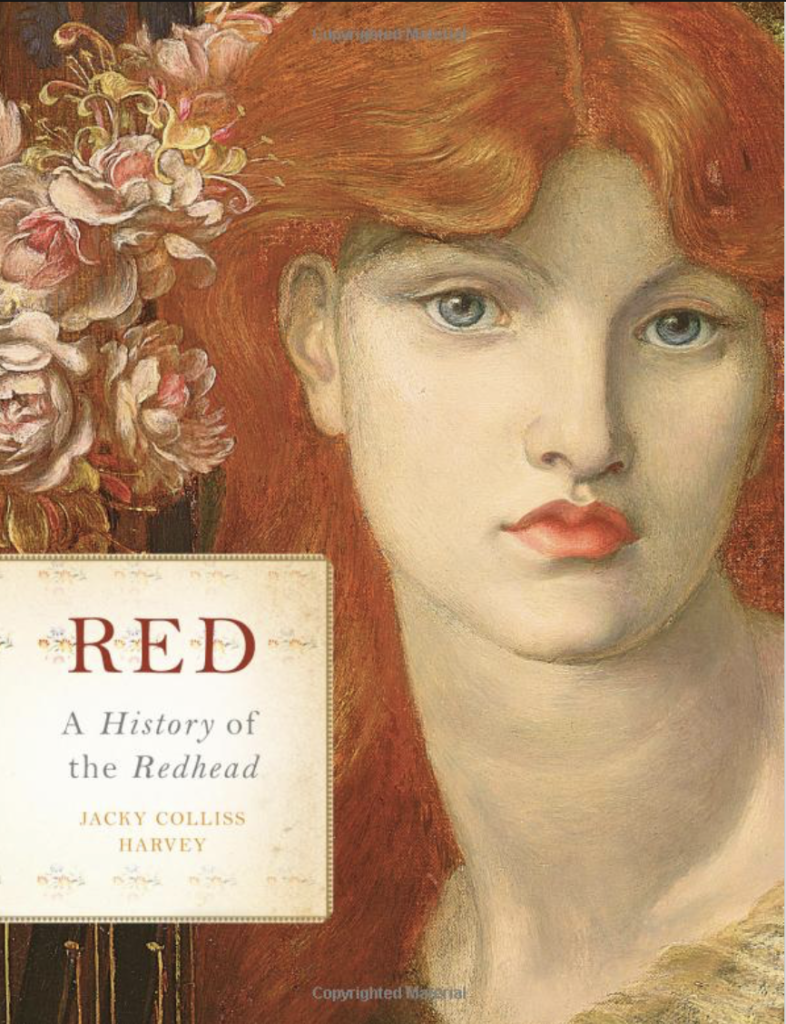
Here is a very short, selective list of more than a dozen known or most probable famous “gingers” in history: Alexander the Great, Emperor Nero, Erik the Red, Frederick Barbarossa, Federico II of Sicily, Henry VIII, Elizabeth I, Antonio Vivaldi, Vincent Van Gogh, and Winston Churchill. Following are some arguable redheads where it is not so easily confirmed or may be just hearsay: Fatima (daughter of Mohammed), Charlemagne, Galileo Galilei and Mozart, where some information may conflict. Nonetheless, modern DNA studies have also surmised that some of our ancestors like the Neanderthals (Homo neanderthalensis) certainly carried redhead genes and many may have been indeed redheaded as new studies assert about both genomes. That they were unstoppable is ironic in that the Neanderthal species ultimately became extinct overall, but not before our two human “families” had interbred with at least 300 possible matings around 25,000 years ago to produce up to 5% of our current Homo sapiens DNA. An article from the January 6, 2008 issue of Current World Archaeology attests redheadedness as a common Neanderthal trait: “Hair Colour of Neanderthals Revealed” from the sequenced MC1R gene. This amused reconstruction below sort of implies an appreciated joke – maybe on us – as Neanderthals taught us much about toolmaking and how to survive the cold, maybe even becoming less thin-skinned in the process in more ways than one. My archaeologist husband took this photo below in the Mettmann Neanderthal Museum in Germany while he was leading a National Geographic Expedition.

Clearly some of these “redheads” made very positive contributions to civilization and history; others like Nero not so much (or worse) and some are ambiguous in terms of beneficial impact. I’ll give a few words or possibly relevant anecdotes about many of these figures in chronological order, first the known individuals, and second only the rumored ones, with relevant images or portraits where possible.
In antiquity we may have as a redhead Alexander the Great (356-23 BCE), Macedonian world conqueror with the Greeks, Roman Emperor Nero (37-68 CE) followed at the end of the first millennium CE by Viking Erik the Red (ca. 950-1003 CE), and then Frederick Barbarossa (1122-90 CE) and Federico II of Sicily (1194-1250 CE) shortly thereafter. In the Renaissance are Henry VIII (1491-1547) and his equally-powerful daughter Elizabeth I (1533-1603). In the Baroque Era we find composer Antonio Vivaldi (1678-1741) and at the end of the 19th century, are revolutionary artist Vincent Van Gogh (1853-1890) and bridging the modern world British statesman Winston Churchill (1874-1965). As mentioned, less certain or merely circumstantial redheads are Fatima (ca. 604-32 CE) the daughter of Mohammed, Frankish king and Holy Roman Emperor Charlemagne (747-814 CE), pioneering mathematician and astronomer Galileo Galilei (1564-1642) and genius composer Wolfgang Amadeus Mozart (1756-91).
Alexander, highly-driven, strong-willed and unpredictable or impetuous at times, was not only stubborn – a good characteristic if obstacles got in his way that would have stymied others, but he was often hotheaded even if universally acknowledged to be an inventive military genius. One written source was Aelian (2nd c. CE) who claimed Alexander hair color was strawberry blonde or light reddish. Alexander was ironically said by Plutarch to have visited the Delphic Oracle to prophetically hear his destiny. Always in a hurry it seems, on finding the Delphic priestess unavailable when he arrived in Delphi, young Alexander grabbed her by the arm and dragged her out unwillingly to the sanctuary, where she angrily retorted, “You can’t be stopped, can you?” He took that involuntary quip as the prophecy he desired, happily leaving as quickly as he came, as he impatiently had a world to conquer.
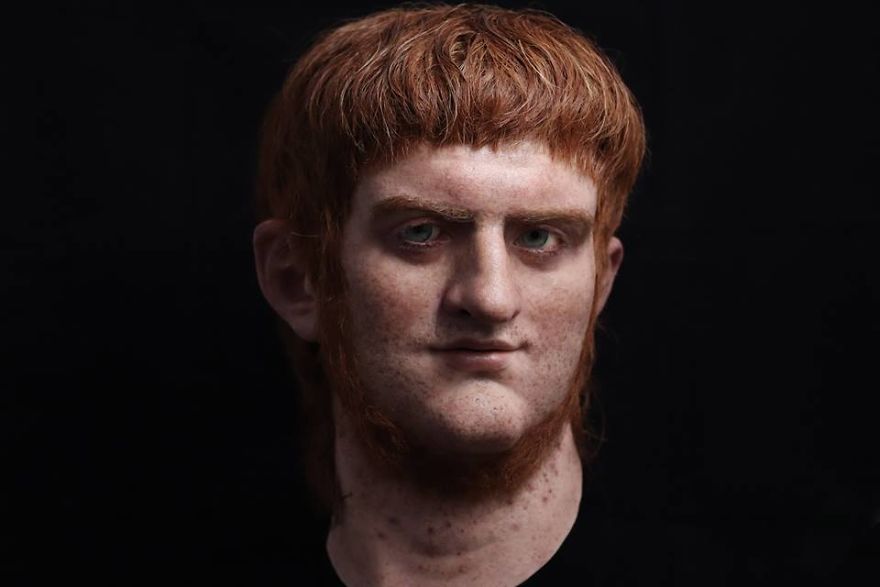
It might be hard to say anything positive about Nero, although some have recently tried to rehabilitate his image. His emperorship was suspect from the first day if his conflicted mother Agrippina did indeed poison her third husband, his step-father Emperor Claudius in 54 CE as contemporaries say. He was notoriously prickly, suspicious to the point of paranoia, hot-headed and mercurial, and while he likely did not burn Rome down personally in 64 CE, he did apparently eliminate his mother and a wife without much conscience, let alone bankrupt the Roman treasury with his extravagances. His family name was Ahenobarbus, meaning “red-bearded” like his father and according to gossipy Suetonius, Nero was born during a fiery red dawn, which for the Romans was a bad omen of things to come.
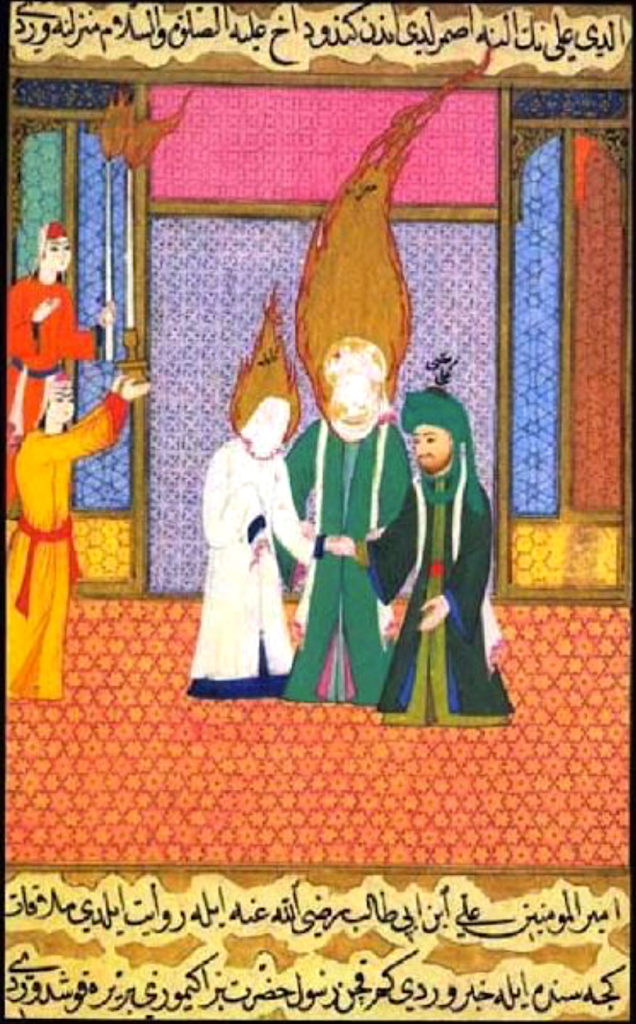
A far more positive person almost universally admired, Fatima al- Zahra, beloved daughter of Mohammed, is held up as the most influential and exalted woman in the Moslem world. She was a huge support both to her father and her husband Ali, later caliph and Shi’a imam, by whom she bore the apple of their grandfather’s eyes, Hasan and Husain, both of them also regarded as respected imams. Fatima was described as being radiant “like the moon on its full night or the sun covered with no clouds…” The Hamza of Fatima or Hand of Fatima is said to be a protective commemoration of Fatima. Because of anti-iconic law in Islam, there are few accepted portraits of her but the one used here has a divine flaming nimbus both around her father Muhammed’s head and her head with her wedding to Ali. That “flame” is reminiscent to a less divine redhead more like the rest of us, but we are told she also colored her hair red with henna even if that wasn’t its original color.
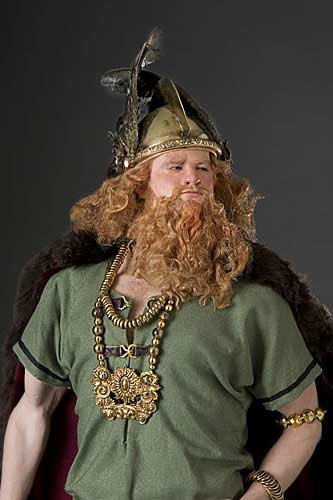
Viking king Eric Thorvaldsson the Red, actually Eirikr Rauða in Old Norse or other variants, was instrumental in sailing in just about any weather to Greenland. He was probably not have been the first to discover it, however, he was stubborn enough to colonize it after a Viking public relations campaign persuading his followers in Iceland that Greenland to the west was better with more appealing weather and a more positive name. His son Leif followed his father’s boat wake all the way to North America and Newfoundland. Icelandic sagas about Eric include Eiriks Saga Rauda (13th c.) and Graenlendinga Saga (14th c.), both likely earlier but only preserved centuries later. His name most likely comes from either red hair or beard or both. There is little question that redheadedness is a common Scandinavian trait, where there is perhaps the highest percentage of redheadedness in the world along with Ireland, where the Vikings also roamed.
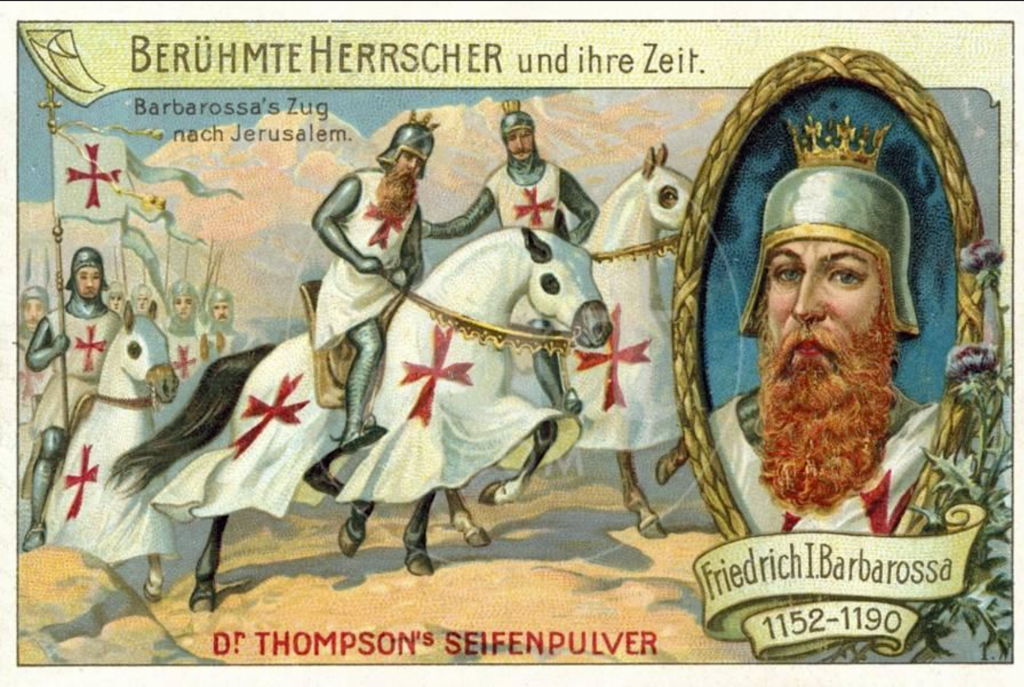
Holy Roman Emperor Frederick Barbarossa’s second name Barbarossa meant “redbeard” in Italy where he waged about a dozen campaigns, so it is probably an accurate descriptive epithet, being similarly Kaiser Rotbart with the same meaning in his German homeland. Although fractious and often engaged in power struggles against a succession of popes, he was one of the few regents who protected Jews in Medieval Germany, although because the Germanic states were so fractured, his protection was not universal nor was it permanent. One of the few nobles to be gallivanting around the world in two crusades, he died in 1190, drowning in the Saleph (now Silifki) River floods while on the Third Crusade in the East near Armenia. His main burial was in the Church of St. Peter in Antioch but his bones were buried in Tyre while his heart and viscera were buried in St. Paul’s Church in Tarsus, Turkey. This dispersion of his remains is ironic because he likewise pilfered Charlemagne’s tomb in Aachen and claimed some of his predecessor Charlemagne’s bones as both an ancestral privilege and proof of claim to emperorship. His vast ambition was almost as legendary as his military prowess, charisma and political savvy. According to some accounts, he likely drowned while attempting to swim across the river against all advice – he was apparently an adept swimmer – and was swept away by the current; others say he was thrown from his horse in the river and weighed down by heavy armor. Being pickled at first in vinegar for the homeward journey, his body never made it back to his native Germany.

Frederick II (aka Federico Due) Holy Roman Emperor – elected in Rome in 1220 – and king of Sicily and Southern Italy was a polymath genius who spoke at least six languages including Arabic and wrote in five, his nickname being Stupor Mundi or “wonder of the world” in Latin. He was excommunicated three times by several popes, partly because he didn’t shed a drop of Saracen blood in the Sixth Crusade, ending it instead by taking Jerusalem through marriage to the daughter of the Christian King of Jerusalem. He also incurred the wrath of the Papacy by promoting Moslems and Jews and ecumenicism in his efficiently-run Sicilian kingdom. He was also a religious skeptic and a scientist writing an ornithologically-minded book on falconry (De arte venandi cum avibus) that reads like a natural science text, as well as a composer of music and poet. He was apparently also a jokester, playing jokes on the visiting St. Francis of Assisi. His Liber Augustalis law code was ahead of its time and he had also banned trial by ordeal. One physical description of a Damascus chronicler, Sibt ibn al-Jawzi, stated “…the emperor’s head was covered in red hair where not going bald and he was near-sighted…with green eyes like a snake,” no doubt the last bit because of his well-attested cunning.
Antonio Vivaldi from Venice was one of the most prolific composers of the Italian Baroque. His irrepressible music is performed apparently at least once every day somewhere around the world, often from his 1723 The Four Seasons: The Contest Between Harmony and Invention, and he was highly influential to other Baroque composers like Johann Sebastian Bach who copied out and adapted 10 Vivaldi orchestral concerti for keyboards. Vivaldi has been even imitated in early-to-mid 20th century music, for example, Concerto in C by Fritz Kreisler. A string virtuoso, Vivaldi wrote at least 300 concerti, at least 46 operas and at least 100 choral works. Because he was redheaded and a secular priest who led a Venetian convent orphanage orchestra of foundling girls at Ospedale della Pietà, he was affectionate known as il Prete Rosso, “The Red Priest”.

Wolfgang Amadeus Mozart child prodigy but equally adult genius composed at least 800 works in less than 30 years and as a melodist alone was unforgettable. He often said as a measure of success he wanted folks to leave a performance humming one of his melodies. If so, he was incredibly successful with so many memorable melodies. His sense of humor shines through his letters as well as his music: my husband and I entertained our children by singing snatches of his winsome Papagena-Papageno duet to them. If he was dragged around Europe in a carriage as a child by his father Leopold, at least he felt through the seat how bumpy the roads were. There is a apparently a lock of his childhood hair in the treasury of the high mountain monastery Hospice du Grand-St-Bernard, snowbound much of the year as he stayed there at least once. Having driven the still twisty Alpine roads myself more than a few times with dizzying cliffs to the side, I’m sympathetic, but maybe he composed syncopated themes along the bumpy way. Another lock of young Mozart’s hair seems to be red or at least reddish from the Mozarteum in Salzburg from his youth, but the jury is still out on that. Because he wore a periwig most of the time even as a child, it’s hard to determine from contemporary accounts or portraits. The Salzburg 1782 portrait of him now in the Mozarteum by his brother-in-law Joseph Lange – shown here – is in determinate at best.

Vincent van Gogh, a true redhead seen in the lead image above, is acclaimed now as a genius but not during his difficult lifetime, was tortured by multiple addictions and disease. Although deeply religious as a young man while equally independent in his interpretations of spirituality, few know he studied theology in his native Holland and aspired at first to be a clergyman until this was ultimately derailed by his problems, including liaisons to prostitutes and a debilitating syphilitic condition. Often an impoverished outcast, it is uncertain whether he was bipolar or suffered some other emotional and mental afflictions, but it is certain that his addictions didn’t help his mental state as both heavy tobacco and absinthe use were daily rituals. If his unique visionary paintings take on the luminous aura of hallucinations at times, it can only be wondered how much of it was already latent or instead exacerbated by his addictions to toxic and psychotropic agents. But it cannot be denied that he was one of the most revolutionary painters in history whose intense paintings in France have changed art forever. His many self-portraits highlight his flaming red hair as well as his honesty about where he seemed to be heading in a downward psychological spiral. Regardless of what others thought of him at the time, Van Gogh’s own self awareness of genius did not let his pain or self-inflicted problems stop him from creating some of the most mesmerizing paintings of all time.

While I have no illusions to greatness or being unstoppable, I’ve included a photo of myself in Greece in 1987 as the final image here, although note I’m not so ginger-haired now in 2023. But my younger hair did look like it was on fire in the right light.